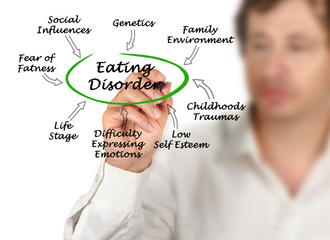Written by: Hannah Podhorzer
Professional Relations Representative, The Renfrew Center of Chicago
Food insecurity contributes to elevated eating disorder behaviors, shame and stigma. Here’s some information to explore when working with clients experiencing this intersection of food insecurity and eating disorders.
The picture of who develops an eating disorder has historically been limited. Many envision a White, thin, adolescent female. She is often affluent. They might even think an eating disorder is a “vanity” or “indulgence” that wealthier people can “afford.” Yet, this misleading trope can have serious consequences. It renders invisible the experiences of countless individuals who don’t fit that narrow mold.
But what if we sought out a different story? Research in the past five years, shaped by the lived experiences of those with eating disorders, has shed light on a different narrative. One in which our external economic and food environments impact our internal thoughts, emotions and eating behaviors.
What is Food Insecurity?
According to Feeding America, food insecurity is a lack of stable access to enough food for every person in a household to live an active, nourishing life. The USDA outlines four ranges of food security, from very low to high food security. Food insecurity is impacted by social determinants of health, such as where we live, our access to transportation, our housing (even what kitchen appliances we can store food in), as well as our income. While impacting many demographics, there are higher levels of food insecurity among Black, Indigenous, and People of Color (BIPOC) as well as the LGBTQIA+ community.
Rates of food insecurity have also been further exacerbated by the ongoing COVID-19 pandemic. As the months have gone on, economic challenges continue to impact families’ levels of food security. Over 38 million Americans currently face food insecurity in the United States.
What Research Reveals About Food Insecurity’s Effect on Eating
You may wonder where this connects with eating disorders and disordered eating. Many of us at the beginning of lockdown in the United States saw viral images of empty grocery shelves and consumers stockpiling foods. For clinicians treating eating disorders, it may have seemed apparent that these images, and the stories they contained, pointed to what could be a very triggering time for patients with eating disorders. It has been a doubly fraught time for individuals also impacted by food insecurity.
Pioneering research these past five years has demonstrated a link between how our external food environments of food insecurity impact our emotional responses and eating behaviors. Researchers have uncovered that individuals with the highest level of food insecurity also endorse significantly higher levels of binge eating, dietary restraint, body dissatisfaction, weight self-stigma, and worry.
How might this unfold? Well, when the flow of food is constrained to one certain day of the week, or even the month, as one awaits a check from work, or government assistance benefits, an individual might consume a large quantity of food followed by a prolonged scarcity of food. The physical environment contributes to this binge-restrict cycle. Shame and guilt evoked from that experience can fuel purging behaviors such as vomiting, laxative abuse, and over-exercising.
And why else might individuals struggling with food insecurity engage in disordered eating patterns? Some may want to minimize the impacts of hunger for other family members, seek to lose weight, “stretch” those aforementioned budgets or benefits to make food last longer, or prioritize other expenses, such as rent, or medical visits.
From a psychological standpoint, both real and perceived scarcity impacts our cognitive capacities, shifting our focus and attention to whatever it is we’re lacking. For those experiencing food scarcity, this can manifest as a preoccupation with food, intrusive thoughts about eating, and increased risk of binge eating episodes when food becomes available.
Assessing Food Insecure Patients
Medical and mental health providers should screen both for eating disorders in food insecure patients, and food insecurity in patients presenting with eating disorders. There are a few tools you can use:
- The Hunger Vital Sign™ is a simple two-question screener. This quick assessment classifies households as being at risk for food insecurity if they answer that either or both of the included statements is often or sometimes true.
- If you are looking for a more in-depth assessment, you can explore the USDA’s list of food insecurity surveys, including those for adolescents, that have been translated into multiple languages.
After assessing patients, you can explore further if they are engaging in dietary restraint due to weight and shape concerns, socioeconomic concerns, or any other reasons.
How You Can Support Clients Who Have Food Insecurity
As you complete these assessments and approach these conversations, a reminder that there is often a stigma associated with food insecurity. Asking all patients about access to all foods as a dimension of health can be a necessary, sensitive, and considerate exploration no matter the patients’ scores.
It is important to note that in public health discourse, food insecurity is often labeled as an issue contributing to individuals eating increased amounts of “unhealthy” foods. Working with your patients to (re)define health and shift the conversation to accessing all kinds of foods that are culturally relevant, that meet individualized hunger, satiety, nutritional needs, and satisfaction will be key in helping patients develop a healthier relationship with food in the context of past or present food insecurity.
Cultivating a multidisciplinary team, including a specialized therapist, dietitian, primary care provider, and other local resources is essential for eating disorder recovery. As a provider, you can work to develop a consolidated list(s) for your clients of governmental assistance and local resources combating food insecurity.
- Governmental programs include SNAP (food stamps), Women, Infants and Children (WIC), Tribal Food Distribution Programs, and School Breakfast and Lunch programs.
- Local programs might be connected to places of worship, senior centers, farmers markets, food pantries, and mobile grocery stores.
At Renfrew, we value the multidisciplinary approach as we know eating disorders are multidimensional. We realize that food insecurity, particularly in a ravaging pandemic, obstructs access to the food needed to jumpstart and maintain eating disorder recovery.
Dietitians at Renfrew can factor food insecurity into designing meal plans. Our dietitians can explore with patients how to manage triggers associated with an inconsistent supply of food, while also handling questions around food storage and preparation.
Our Day Treatment and Intensive Outpatient Programs are currently operating virtually, so that geography and transportation do not have to be added barriers.
How You Can Help Fight Food Insecurity
It may feel hard to fight food insecurity within just the confines of your office. While you are making a huge difference in connecting clients to much needed resources, there are countless avenues to get involved in advocacy and service in your own community. Contacting your representatives about your concerns, volunteering at a food bank, organizing a food drive, donating needed foods if you are financially able, and supporting BIPOC-operated food justice initiatives are just a few ways to make a large-scale impact on your patients, their families, and your wider community.
Conclusion
New research has uncovered the influences of food insecurity on overall eating disorder pathology, highlighting one example of how eating disorders impact marginalized communities. Providers can play a crucial role in assessing and treating eating disorders among patients also experience food insecurity. As a multidisciplinary team, using screeners, broaching the subject with compassion, and getting patients connected with local programs can cultivate a community-based support system. Nurturing recovery with an understanding of patients’ lived experiences is key for social justice-informed eating disorder treatment and meets clients exactly where they are.
https://health.gov/healthypeople/objectives-and-data/social-determinants-health



